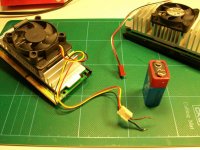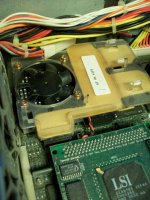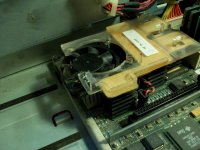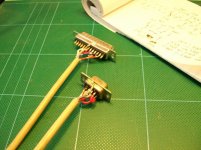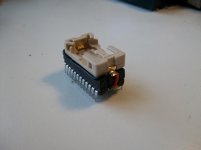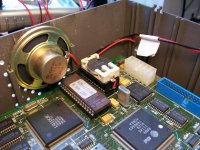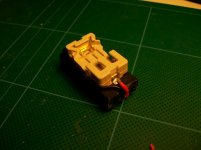ajcc
Experienced Member
Hi guys!,
So during the last two years I've managed to find some old SUN Microsystems computers, all given to me by very generous people. Since they're old now, time goes fast! I thought someone might be interested in my bad habit of carrying heavy computers home by bus.
My latest one is a SUN IPX (given to me by pontus on the forum, thank you again!). The reason I start with this SUN is because of the SUN IPC I had years ago, which I picked up some 80 km (50 miles) from home, with a huge black&white CRT. When I got back to my hometown I had my bike parked right next to the bus stop, took the IPC in my rucksack (backpack), the CD-player and keyboard in a fabric bag and the monitor on the rear rack on my bicycle. Sadly I never got to play with it for very long as the hard drive crashed, and I was stupid enough to throw it away some years later after it haven't booted (or shown any signs of life).
Que the future of today:
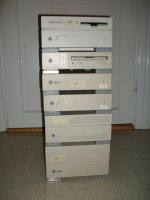
Yes, I did actually carry all those drives with me on the bus! Although one of the hard drive cabinets was really heavy and had to go into the rucksack, so I couldn't carry the IPX in my rucksack this time around. (There was also a SGI Indy carried along with all that, but more on that in a later thread).
And today I finally managed to get around building a custom null-modem cable for the IPX (No modem for you!). I bought a Macintosh to Modem cable at a thrift shop earlier this week, 10 minutes before closing because I had to work late that day. Since I had used one of those cables with my IPC, I knew they worked, although that time around I hooked it up to a null-modem cable. As it turns out the Makers of Macintosh Modem Adapter Cables(tm) didn't wire up anything that wasn't required for talking to a modem. Being a bit confused by this, I started to slowly accept the fact that I couldn't do any handshaking. After some thinking I concluded that the null-modem cable I used to have, must have just terminated the ends into themselves and didn't actually include any wires for handshaking (and those cables were expensive too!).
Here's soldered up the cable before the grey plastic shell was mounted:
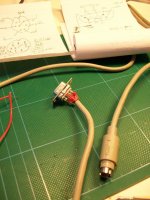
And it worked! (I checked everything a couple of times, and then another time...)
Maxed out RAM!, thank you pontus!
And there you go! It's alive! It's really quiet too before the harddrive gets to spin up.
It's really quiet too before the harddrive gets to spin up.
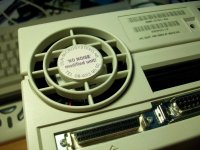
There's also a cat sleeping inside.

Someone have piggy backed on some large AA-batteries onto the NVRAM, unfortunately they are empty (the self discharge rate of those puppies must be quite high!).

The hard drive is from a Compaq:
It didn't boot
And that's how far I've got.
So during the last two years I've managed to find some old SUN Microsystems computers, all given to me by very generous people. Since they're old now, time goes fast! I thought someone might be interested in my bad habit of carrying heavy computers home by bus.
My latest one is a SUN IPX (given to me by pontus on the forum, thank you again!). The reason I start with this SUN is because of the SUN IPC I had years ago, which I picked up some 80 km (50 miles) from home, with a huge black&white CRT. When I got back to my hometown I had my bike parked right next to the bus stop, took the IPC in my rucksack (backpack), the CD-player and keyboard in a fabric bag and the monitor on the rear rack on my bicycle. Sadly I never got to play with it for very long as the hard drive crashed, and I was stupid enough to throw it away some years later after it haven't booted (or shown any signs of life).
Que the future of today:

Yes, I did actually carry all those drives with me on the bus! Although one of the hard drive cabinets was really heavy and had to go into the rucksack, so I couldn't carry the IPX in my rucksack this time around. (There was also a SGI Indy carried along with all that, but more on that in a later thread).
And today I finally managed to get around building a custom null-modem cable for the IPX (No modem for you!). I bought a Macintosh to Modem cable at a thrift shop earlier this week, 10 minutes before closing because I had to work late that day. Since I had used one of those cables with my IPC, I knew they worked, although that time around I hooked it up to a null-modem cable. As it turns out the Makers of Macintosh Modem Adapter Cables(tm) didn't wire up anything that wasn't required for talking to a modem. Being a bit confused by this, I started to slowly accept the fact that I couldn't do any handshaking. After some thinking I concluded that the null-modem cable I used to have, must have just terminated the ends into themselves and didn't actually include any wires for handshaking (and those cables were expensive too!).
Here's soldered up the cable before the grey plastic shell was mounted:

And it worked! (I checked everything a couple of times, and then another time...)
Code:
EPROM Checksum Test
Power-Up State Test
Context Register Bit Test
Context Register Addressing Test
Segment Map RAM MATS Pattern Test, Context 00000000
Segment Map RAM MATS Pattern Test, Context 00000001
Segment Map RAM MATS Pattern Test, Context 00000002
Segment Map RAM MATS Pattern Test, Context 00000003
Segment Map RAM MATS Pattern Test, Context 00000004
Segment Map RAM MATS Pattern Test, Context 00000005
Segment Map RAM MATS Pattern Test, Context 00000006
Segment Map RAM MATS Pattern Test, Context 00000007
Page Map RAM MATS Pattern Test
Limit 0 Register Test
Counter Interrupt Level 10 Test
Limit 1 Register Test
Counter Interrupt Level 14 Test
WARNING: Unable to determine keyboard type
Synchronous Error Reg Test
Synchronous Error Virtual Address Reg Test
Asynchronous Error Reg Test
Asynchronous Error Virtual Address Reg Test
Asynchronous Error Data Reg1 Test
Asynchronous Error Data Reg2 Test
System Enable Register Bit Test
Cache Data RAM MATS Pattern Test
Cache Tag RAM MATS Pattern Test
PTE Access Bit Test
PTE Modify Bit Test
PTE Write-Protect Bit Test
PTE Write-Invalid Bit Test
PTE Read-Invalid Bit Test
PTE Type 2 Space Bit Test
PTE Type 3 Space Bit Test
Synchronous Timeout Test
Asynchronous Timeout Test
**** 16 MegaBytes Found in Address Range 0x00000000 to 0x00ffffff ****
**** 16 MegaBytes Found in Address Range 0x01000000 to 0x01ffffff ****
**** 16 MegaBytes Found in Address Range 0x02000000 to 0x02ffffff ****
**** 16 MegaBytes Found in Address Range 0x03000000 to 0x03ffffff ****
DRAM Word MATS Pattern Test (0x00fe0000 - 0x01000000)
Parity/Memory Control Registers Bit Test
33-bit SIMM Parity Test
Interrupt Register Test
Software Interrupt Level 1 Test
Software Interrupt Level 4 Test
Software Interrupt Level 6 Test
NVRAM Access Test
FAILURE: NVRAM (f2000003) Battery Failure, Exp = 000000aa, Obs = 00000055Setting Segment Map
Setting RAM Parity Mode
Mode set to 33-bit
Sizing Memory
Mapping ROM
Mapping RAM
Probing /sbus@1,f8000000 at 0,0 dma esp sd st le
Probing /sbus@1,f8000000 at 1,0 Nothing there
Probing /sbus@1,f8000000 at 2,0 Nothing there
Probing /sbus@1,f8000000 at 3,0 cgsix
Can't open input device.
SPARCstation IPX, No Keyboard
ROM Rev. 2.3, 64 MB memory installed, Serial #16777215.
Ethernet address ff:ff:ff:ff:ff:ff, Host ID: ffffffff.
The IDPROM contents are invalid
Power-On SelfTest FAILED ... Replace TOD/NVRAM
Testing 64 megs of memory. Still to go 64 63 62 61 60 59 58 57 56 55 54 53 52 51 50 49 48 47 46 45 44 43 42 41 40 39 38 37 36 35 34 33 32 31 30 29 28 27 26 25 24 23 22 21 20 19 18 17 16 15 14 13 12 11 10 9 8 7 6 5 4 3 2 1 0
SBus slot 0 le esp dma
SBus slot 1
SBus slot 2
SBus slot 3 cgsix
Initializing 48 megs of memory at addr 1000000 47 46 45 44 43 42 41 40 39 38 37 36 35 34 33 32 31 30 29 28 27 26 25 24 23 22 21 20 19 18 17 16 15 14 13 12 11 10 9 8 7 6 5 4 3 2 1 0 Initializing 16 megs of memory at addr 0 15 14 13 12 11 10 9 8 7 6 5 4 3 2 1 0
Type b (boot), c (continue), or n (new command mode)
>b
Boot device: /sbus/le@0,c00000 File and args:
Internal loopback test --
Did not receive expected loopback packet.
Can't open boot device
Type b (boot), c (continue), or n (new command mode)
>n
Type help for more information
okMaxed out RAM!, thank you pontus!
And there you go! It's alive!

There's also a cat sleeping inside.

Someone have piggy backed on some large AA-batteries onto the NVRAM, unfortunately they are empty (the self discharge rate of those puppies must be quite high!).

The hard drive is from a Compaq:
Code:
ok probe-scsi
Target 0
Unit 0 Disk COMPAQ ST12550N 322300425332Copyright (c) 1994 Seagate All rights reserved 0000It didn't boot
Code:
ok boot /sbus/esp@0,800000/sd@0,0
Boot device: /sbus/esp@0,800000/sd@0,0 File and args:
Bad magic number in disk label
Can't open Sun disk label package
Can't open boot deviceAnd that's how far I've got.

